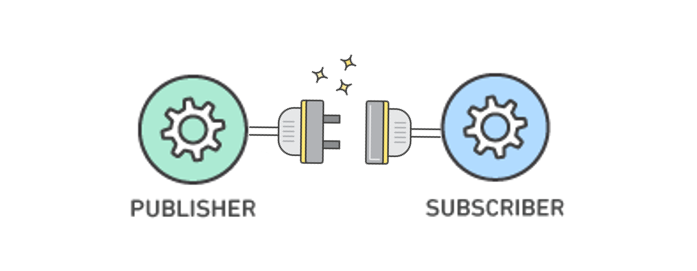Understanding Publisher-Subscriber Pattern in JavaScript: A Beginner’s Guide
 NonStop io Technologies
NonStop io Technologies
Have you ever used YouTube’s notification system? When you click that bell icon, you tell YouTube, “Hey, let me know when this channel posts something new!” This is a real-world example of the Publisher-Subscriber pattern, commonly known as Pub-Sub. Let’s dive into what this pattern is and how we can use it in JavaScript!
What is the Publisher-Subscriber Pattern?
The Pub-Sub pattern is like a messaging system where:
Publishers (senders) send messages without knowing who will receive them
Subscribers (receivers) receive messages they’re interested in without knowing who sent them
There’s usually a message broker or event bus that handles the communication
Think of it like a newspaper service:
The newspaper company (publisher) produces news
Readers (subscribers) subscribe to the newspaper
The delivery system (event bus) ensures the right newspapers reach the right readers

Building a Simple Pub-Sub System
Let’s create a basic Pub-Sub system in JavaScript:
class EventBus {
constructor() {
// Store all subscribers
this.subscribers = {};
}
// Subscribe to an event
subscribe(event, callback) {
if (!this.subscribers[event]) {
this.subscribers[event] = [];
}
this.subscribers[event].push(callback);
// Return unsubscribe function
return () => {
this.subscribers[event] = this.subscribers[event]
.filter(cb => cb !== callback);
};
}
// Publish an event
publish(event, data) {
if (!this.subscribers[event]) {
return;
}
this.subscribers[event].forEach(callback => {
callback(data);
});
}
}
// Usage Example
const eventBus = new EventBus();
// Subscribe to 'userLoggedIn' event
const unsubscribe = eventBus.subscribe('userLoggedIn', (user) => {
console.log(`Welcome back, ${user.name}!`);
});
// Publish 'userLoggedIn' event
eventBus.publish('userLoggedIn', { name: 'John' });
// Output: Welcome back, John!
// Unsubscribe when no longer needed
unsubscribe();
Real-world analogy:
Think of it like a YouTube notification system:
The EventBus is YouTube’s notification system
subscribe()is clicking the "bell" iconpublish()is when a creator uploads a videounsubscribe()is clicking the bell icon again to stop notificationsThe callback is what your phone does when it receives the notification (shows an alert)
Each time something happens:
The system checks who wants to know about it
Tells everyone who subscribed exactly what happened
Each subscriber can then do whatever they want with that information
Benefits of Using Pub-Sub
Loose Coupling
Publishers and subscribers don’t need to know about each other
It makes code more maintainable and easier to modify
Scalability
Easy to add new subscribers without changing existing code
Publishers can broadcast to multiple subscribers efficiently
Flexibility
Components can be modified independently
It is easy to add or remove features without breaking other parts
Better Organization
Helps separate concerns in your application
It makes code more modular and easier to test
Popular Frameworks and Libraries
Redis Pub-Sub
import Redis from 'ioredis';
const publisher = new Redis();
const subscriber = new Redis();
subscriber.subscribe('news', (err, count) => {
console.log(`Subscribed to ${count} channels`);
});
subscriber.on('message', (channel, message) => {
console.log(`Received ${message} from ${channel}`);
});
publisher.publish('news', 'Breaking: Big news!');
Socket.io
import { Server } from 'socket.io';
const io = new Server(3000);
io.on('connection', (socket) => {
// Subscribe to event
socket.on('chat message', (msg) => {
// Publish to all clients
io.emit('chat message', msg);
});
});
Real-World Applications
Chat Applications
Users subscribe to chat rooms
Messages are published to all subscribers in the room
Perfect for real-time communication
Social Media Feeds
Users subscribe to other users or topics
New posts are published to subscribers’ feeds
Enables real-time updates
Stock Market Applications
Users subscribe to specific stocks
Price updates are published in real-time
Ensures timely information delivery
Gaming Applications
Players subscribe to game events
Game state changes are published to all players
Maintains game synchronization
Building a Practical Example: Simple Chat Room
Let’s create a basic chat room using the Pub-Sub pattern:
class ChatRoom {
constructor() {
this.eventBus = new EventBus();
this.users = new Set();
}
join(username) {
this.users.add(username);
// Subscribe to messages
const unsubscribe = this.eventBus.subscribe('message', (data) => {
if (data.sender !== username) {
console.log(`[${username}] received: ${data.message}`);
}
});
// Return methods for user interaction
return {
sendMessage: (message) => {
this.eventBus.publish('message', {
sender: username,
message: message
});
},
leave: () => {
this.users.delete(username);
unsubscribe();
}
};
}
}
// Usage
const chatRoom = new ChatRoom();
// Alice joins the chat
const alice = chatRoom.join('Alice');
// Bob joins the chat
const bob = chatRoom.join('Bob');
// Send messages
alice.sendMessage('Hello everyone!');
bob.sendMessage('Hi Alice!');
// Bob leaves the chat
bob.leave();
Tips for Implementation
Error Handling
Always handle subscription errors gracefully
Implement retry mechanisms for failed publications
Clean up subscribers when they’re no longer needed
Performance Considerations
Limit the number of subscribers per event
Implement message queuing for high-traffic scenarios
Consider using worker threads for heavy processing
Testing
Mock the event bus in unit tests
Test both publishing and subscribing flows
Verify unsubscribe functionality
The Publisher-Subscriber pattern is a powerful tool for building scalable and maintainable applications. It’s especially useful in scenarios where you need loose coupling between components and real-time updates. Start with a simple implementation and gradually add features as needed. Remember to consider error handling and performance optimization as your application grows.
Remember: The key to successful Pub-Sub implementation is finding the right balance between flexibility and complexity. Don’t over-engineer your solution if a simpler approach would suffice!
Subscribe to my newsletter
Read articles from NonStop io Technologies directly inside your inbox. Subscribe to the newsletter, and don't miss out.
Written by

NonStop io Technologies
NonStop io Technologies
Product Development as an Expertise Since 2015 Founded in August 2015, we are a USA-based Bespoke Engineering Studio providing Product Development as an Expertise. With 80+ satisfied clients worldwide, we serve startups and enterprises across San Francisco, Seattle, New York, London, Pune, Bangalore, Tokyo and other prominent technology hubs.